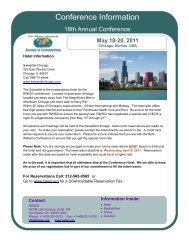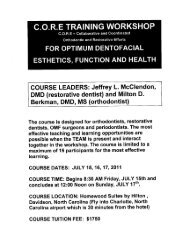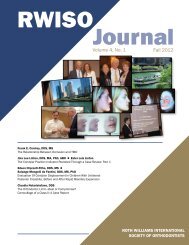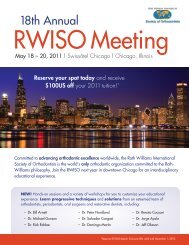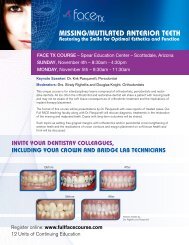2010 RWISO Journal - Roth Williams International Society of ...
2010 RWISO Journal - Roth Williams International Society of ...
2010 RWISO Journal - Roth Williams International Society of ...
Create successful ePaper yourself
Turn your PDF publications into a flip-book with our unique Google optimized e-Paper software.
tionship between the teeth, the joints, and the neuromusculature.<br />
This information provides a physiologic treatment goal<br />
for the orthodontist, a summary <strong>of</strong> which can be made by analyzing<br />
the system in loaded and unloaded conditions. When<br />
loaded, eg, during a swallow, the condyles are fully seated<br />
upward and forward in the fossae, the elevating muscles are<br />
active, and the dentition is in full intercuspation. 41,55,62,63,65,66<br />
When unloaded, the condyles remain in firm and constant<br />
contact with the disc and eminence, elevating muscles are inactive<br />
and positioning muscles (eg, lateral pterygoids) are active,<br />
posterior teeth are out <strong>of</strong> contact, and the anterior teeth<br />
play a major role in guiding mandibular movements. 67-75<br />
Given a reliable perspective <strong>of</strong> optimal static and dynamic relationships<br />
between the teeth, joints, and neuromusculature,<br />
we can consider some additional principles regarding gnathic<br />
function. There are at least three reasons why the intercuspal<br />
position is important. First, the positions and the shapes <strong>of</strong><br />
the teeth determine mandibular movements at and near the<br />
intercuspal position. 7,50,61,76-100 Second, when the mandible is<br />
brought to full intercuspation in a functionally healthy system,<br />
the powerful elevating muscles are active and the system<br />
is heavily loaded; the bulk <strong>of</strong> the resultant force is absorbed<br />
by posterior teeth. 32,50-52,101-103 Third, condylar position is determined<br />
by the dentition at intercuspation. 61,83,104-106<br />
An additional important factor well supported in the literature<br />
is the clinical observation that the neuromusculature<br />
is exquisitely programmed to guide the mandible to the intercuspal<br />
position80,85-100,107 ; the intercuspal position is dominant<br />
over condylar position. 61,83,103,105,106,108-110 Thus, asking<br />
a patient to “bite down” provides no dependable information<br />
as to where the condyle is positioned. Moreover, efforts<br />
to identify the seated condylar position through clinical<br />
maneuvers such as manipulating the mandible are not reliable.<br />
28,111-116 To quote the master clinician Dr. Thomas Basta,<br />
“Don’t believe what you see in the mouth.” 2 Thus the value<br />
<strong>of</strong> using interocclusal devices such as cotton rolls, anterior<br />
jigs, and splints to deprogram the neuromusculature.<br />
If we are to apply these physiologic principles to the<br />
practice <strong>of</strong> orthodontics, we need additional information<br />
besides that which we have traditionally used; for example,<br />
techniques that record the optimal or “seated” position <strong>of</strong><br />
the condyle. Currently there are numerous such techniques<br />
employed in restorative dentistry. Many clinicians use a hard<br />
stop at the incisor midline to separate the posterior teeth,<br />
along with a s<strong>of</strong>t posterior material that can be hardened<br />
thermally or chemically. When the patient bites against the<br />
hard anterior stop and the neuromusculature seats the condyles<br />
superioranteriorly, the posterior material is hardened,<br />
and the musculoskeletally stable position <strong>of</strong> the mandible is<br />
recorded (Figure 1).<br />
70 Girardot | Physiologic Treatment Goals in Orthodontics<br />
Figure 1 The anterior stop is hard and flat; it separates the<br />
posterior teeth to create appropriate space for a recording<br />
medium. The patient is instructed to close firmly, which<br />
seats the condyles to the musculoskeletally stable<br />
position <strong>of</strong> the mandible.<br />
The information then must be transferred from the patient<br />
to a device that will allow study and treatment planning<br />
<strong>of</strong> the gnathic system in three dimensions. Currently,<br />
the articulator appears to be the best tool for this purpose,<br />
although computer-generated three-dimensional technology<br />
may replace the articulator in the near future. Casts mounted<br />
on an articulator provide invaluable physiological information<br />
for diagnosis and treatment planning. For example,<br />
numerous studies show that there is nearly always vertical<br />
distraction <strong>of</strong> the condyle when the patient closes to intercuspation.<br />
33,113,117-122 It is all but impossible to record, analyze,<br />
and treatment plan this vertical discrepancy without the<br />
use <strong>of</strong> a device such as an articulator.<br />
Joint images are another tool that can serve orthodontists<br />
with regard to physiologic treatment. Tomograms, as<br />
first advocated by Ricketts, have provided an effective way<br />
to study the health <strong>of</strong> the temporomandibular joint and the<br />
position <strong>of</strong> the condyle in the fossa. 123-125 At present, cone<br />
beam CT is a more effective way to study the temporomandibular<br />
joint, as it provides a more-lucid, three-dimensional<br />
view <strong>of</strong> joint structures. 36<br />
There are sound data to support the concept that optimal<br />
gnathic function can be defined and used as an evidence-based<br />
treatment goal. There is little doubt that this<br />
would also aid communication between orthodontists and<br />
other dental pr<strong>of</strong>essionals. In addition, knowledge <strong>of</strong> gnathic<br />
physiology is <strong>of</strong> substantial value to orthodontists in that it<br />
helps them to recognize and avoid myriad problems that occur<br />
in everyday practice. ■



